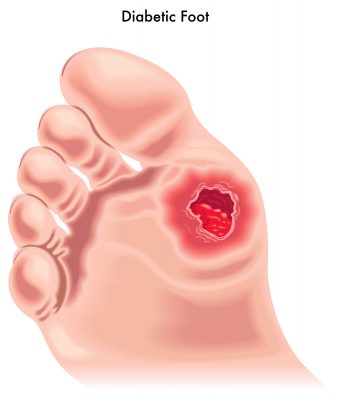
Treating Diabetic Foot In Algonquin, IL
Diabetic foot ulcers occur in approximately 15% of patients with diabetes and if not treated effectively, can lead to severe consequences including infection, hospitalization, and amputation. As podiatrists, we serve as the frontline experts for managing these types of wounds. During your first visit, your physician will obtain plain radiographs of your foot to assess the underlying anatomy and see how this may be contributing to the development of the foot ulcer.
Most patients that have diabetic ulcers are also neuropathic, meaning they have numbness in their lower extremities and are unable to feel pressure differences when walking. It is this inability to feel that is what can cause the ulcers to form and worsen. Depending on the depth of the ulcer, signs of an underlying infection, or if the bone is visible your physician may also opt for advanced imaging to evaluate for infection within the bone.
What Can Help Heal a Diabetic Wound?
Off-loading
Sometimes, a specialized off-loading pad is constructed for the patient so the pressure is avoided at the source of the ulcer. We may even recommend a device called a “Total Contact Cast”.
The cast completely encompasses the foot and the lower leg but still allows you to walk. This does a good job of off-loading and re-distributing pedal pressures so that wound healing can proceed.
Improving Extremity Blood Flow
Without adequate blood flow to the bottom of the foot, diabetic wounds will never heal. We may recommend non-invasive vascular tests to determine your base-line blood flow into your lower extremities. If there are any questions of blockages or abnormal values, we will refer you to a vascular specialist who can assist with getting optimal blood flow to the areas in the foot/ankle that need it the most.
Optimization Of Blood Sugars
It’s vitally important to regulate your blood sugar levels to provide optimal conditions for wound healing. Depending on your HgA1c value and overall blood glucose control, we might refer you to an endocrinologist who can recommend any changes to your diabetic control regimen. Without a good handle on your HgA1c, a diabetic ulcer will have difficulty healing.
Healing Diabetic Wounds With Good Nutrition
Diet is a critical factor in determining how your diabetic wound heals. A diet rich in protein, good fats, and low sugar is crucial to provide the building blocks for cellular integrity and ultimately optimized wound healing.
Wound Infection Control
It is crucial to treat any underlying infection immediately so that the wound can heal effectively. If there is any soft tissue or bone infection and it is left untreated, it could continue to spread and possibly lead to amputation.
FASI Provides Actionable Treatment Plans to Heal Diabetic Wounds
How quickly you get the wound looked at and treated will determine the outcome of the process. Early detection can mean that you are able to negate the effects and allow the wound to heal. Your foot and ankle surgeon will develop a comprehensive treatment plan for you depending on the size and complexity of your diabetic foot ulcer(s). Contact one of our pediatric doctors to schedule a consultation today!

